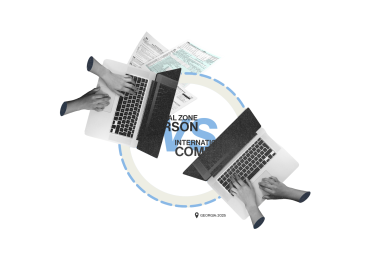Globally, nine out of ten construction projects are finished with budget overruns. According to various sources, project budgets escalate on average by 28% and Georgian construction market is not exempted from this reality. Different stakeholders from the industry in Georgia have confirmed that cost overburdens have been one of the greatest challenges facing the sector throughout the years. They state that most of the projects are finished with budget overruns, very few are within the budget and almost none with budget economy.
The construction sector is a critical pillar of the Georgian economy, contributing 8% to the country’s GDP and employing 8.83% of its workforce. Therefore, it is important to understand and manage the challenges and risks facing the industry. Similarly to global trends, Georgian construction projects face significant challenges with budget escalations. The diversity of past studies conducted to investigate factors leading to construction project cost overruns in different regions, countries and types of construction can be considered as hint that it is a global problem for construction industry. While past studies have analyzed cost overruns globally, limited attention has been given to the Georgian market, particularly from the perspective of construction companies.
Research aimed to detect reasons for project cost overruns in Georgian construction industry from contractors’ point of view and to provide some tools and recommendations for risk mitigation was conducted at Caucasus University[1]. All other studies that have been done beforehand define cost overrun as a difference between the final total cost of the project and the initial estimate or valuation of project’s cost. This definition means that even when the constructor performs the duties within contracted budget, if the owner expected the project to be finished cheaper, it is considered to be performed over budget. In the case of the research conducted for Georgian market, cost overruns are defined as so that only the construction company’s point of view is considered. Therefore, in the given study budget overrun is explained as the additional cost or expense a construction company bears, that reduces the profit from that particular project.
During the research twenty-two different stakeholders from Georgian construction industry were surveyed. Respondents represented construction companies of varied sizes and experience and were mostly from finance and project management departments. The results of the research highlighted fifteen common reasons for cost overruns in Georgian construction projects. Some of those factors occur more frequently than others, and some have a more severe impact on the project budget than others do. Therefore, a risk matrix was created in order to analyze these factors based on their frequency and severity of impact. Results showed that inflation, delays in getting approval from the client regarding the decisions concerning the project during the construction and poor estimating about the project in pre-construction phase are three most frequent and severe factors causing the cost escalation, falling into the red zone of the risk matrix. Of the total fifteen factors none fell under the green zone of the matrix, all other factors were distributed to the yellow zone. These factors include current tendering rules, project schedule changes, delays in payment by the project owner to the contractor, late delivery of materials and equipment to the construction site, lengthy bureaucracy in government entities, mistakes in construction, changes in general laws and regulations, government requirements, frequent breakdown of PPE, market conditions (such as availability of labor and materials), weather conditions and natural disasters.
The research found that inaccurate time and cost estimations and current tendering rules cause the project budgets to escalate on average by 10% each. Followed, by inflation causing escalation of 7%, schedule changes by 5%, delays in getting approval from the project owner regarding the construction project and market conditions by 3% each, and other factors listed lead to expenses to escalate on average by 1% each.
Globally construction project profit margins range from 3-7%, or as some sources state from 8% to 15%. As the finance representative of Georgian construction company mentioned during the interview, these margins in Georgia range from 5% to 10%, depending on the characteristics and specifications of the project. These percentages are included in the initial project budgets and construction companies have expectations to profit by this amount from particular projects. Looking at the latest financial statements of three different Georgian construction companies, which are of different size and experience, it is obvious that for past two years the gross profit margin for these companies varied within the range of 6% – 11% and the net profit margin range was 1% – 5%. Comparing these profit margins to the percentage of cost overruns caused by each factor, it is obvious that the cost escalation percentages are too high. Therefore, it is important to address this challenge, find some mitigation tools, understand their pricing, and calculate how much they increase the costs in the budget of the project. This creates the ground for the analysis of whether or not it is reasonable to use these tools against the risks of incurring cost overruns. But as construction is a complex business and every new project has its unique characteristics and needs, not all risks can be eliminated at once. Nevertheless, study suggests some tools that can help. Examples of those tools are contractors’ all risk insurance (CAR), bank guarantees (BGs), types of contracts and changes in current tendering systems.
Starting with the Contractors’ All Risk insurance, also known as CAR. This is an insurance instrument that covers property damage and third-party injury or damage claims. CAR covers a wide range of risks. It is a non-standard policy, and its scope may vary depending on and tailored to the specific needs of the project. The total sum insured with CAR depends on the total value of the project. There is no pre-defined formula for premium definition. According to the presentation provided by one of the leading insurance companies in Georgia, under CAR policy the insurance covers the following: construction site, materials stored on the project territory, temporary buildings, warehouses, MEP systems, any property placed on the construction site that is needed for the construction process and machinery. Additionally, existing property and buildings, debris removal and inland transits can be added to the standard insurance policy. Results of the study mentioned above showed that currently only 72% of the Georgian construction companies that were surveyed use this insurance instrument. Most of them use CAR only upon the project owners’ request.
Second tool described in the research is Bank Guarantees (also referred to as BGs). BG has three parties, the issuer bank, beneficiary, and applicant. The applicant is the party that has obligations to fulfill due to the contract, beneficiary is the party that benefits from the guarantee and is insured against the financial risks, and issuer bank plays a role of an intermediary between these two. In the case when an applicant company is not fulfilling its obligations, a bank guarantee is a reassurance that the second party will be reimbursed by the issuer bank for the costs or losses incurred. Therefore, BGs reduce financial risks for the beneficiary. Several types of bank guarantees exist, examples are advance payment guarantee, guarantee of payment, performance guarantee and defect liability guarantee. In the case of construction companies, performance guarantee is the most applicable type of BG to manage relationships with subcontractors and suppliers. When there is a performance guarantee the beneficiary is reimbursed by the bank in case the applicant does not perform, improperly or incompletely perform the obligations defined in the contract. For example, in the case when a supplier is late on delivering materials or subcontractor delays jobs, holding a bank guarantee from that other party will ensure that no additional costs are incurred. Therefore, this will not lead to budget overrun. On the one hand, it creates incentives for subcontractors and suppliers to deliver the obligations according to agreed-upon terms. And secondly, a bank guarantee provides financial security in situations when terms and conditions of agreements are not met. A construction company can also use bank guarantees to regulate the relationship with project owners. Guarantees of payments, which are another type of BG, are a valuable tool to prevent delays in payment by the project owner to the contractor. Simply explained, if the construction company holds a bank guarantee and the terms of payment included in this agreement are violated bank will be responsible for the payment, therefore construction company will not endure additional challenges and cost overruns due to the overdue payment.
As a rule, those relationships between the project owner and the construction company are regulated by the general agreement between them. In construction several types of contracts can be used, the two common ones are lump-sum and open-book contracts. Lump-sum contracts are fixed-price contracts, where the budget for the construction project is fixed and does not change throughout the project duration. The budget allocation, expenditure management and profit margin calculations are up to the contractor construction company, as long as all of this is performed within the given budget. From the project owners’ perspective, the total expenditures are fixed. Therefore, the construction company bears price and labor fee fluctuations and other risks. Lump-sum contracts provide a great advantage for a project owner as it is a reassurance that the project will be finished within a certain budget, unless the project owner makes scope changes, or any unforeseen event happens. But for the construction company, this type of contract has high financial risk, as the maximum amount received from the project is gapped and there is a considerable risk of not getting the desired and precalculated profit. Contrary, in cost-plus contracts, which is also known as “open book” method, contractor is reimbursed for every cost associated with the project plus the agreed upon profit mark-up. This model guard’s construction companies against price escalations but gives the project owner more involvement in the construction process, which may lead to frequent changes in project scope. construction companies do not always have freedom of choice and generally the project owner predetermines the contract type. But in some cases, especially when construction companies hold bargaining power, the type of contract may be the subject of negotiations. In that case, from the constructors’ point of view the open book method is more desirable. This ensures less financial risk for the contractor company. Therefore, the cost-plus contracts may seem to hold less profit mark-up than initially calculated lump-sum contract, but as the results of the research showed price and labor fee fluctuations are one of the most common factors leading to project cost overrun. Therefore, being secure against these risks is especially important.
Another challenge highlighted during the research was current tendering system in Georgia, which grants the win to the lowest bidder. This tends to create an incentive to misrepresent numbers in terms of budget and duration of the project. That consequently leads to cost overruns as those misrepresentations cannot be met. Based on the literature available it can be concluded that globally most countries use more or less similar tendering systems, but some examples of best practices still exist that describe how this problem can be minimized. Not all factors are directly linked to the tendering systems, for example bias and poor estimating were named as a stand-alone factor. But when diving deeper into the issue it is obvious that the incentive to misrepresent or underestimate a project is caused by the fact that the lowest bidders win. Therefore, up to 20% of cost overrun can be avoided by having a tendering system similar to the countries that do not grant the win to the lowest bidder and take into the consideration the experience, capabilities, and past excellence of the construction companies. For instance, Singapore has a centralized registry system for construction companies, where every firm that wants to participate in bidding has to sign up. Grading is conducted based on the company’s financial capacity, personnel, record of accomplishment, management, and development. Depending on which group a construction company is assigned, it has a limit of total project value for which it can bid. This kind of differentiation creates a security as a construction company will not be able to undertake a project outside of its capacity.
Summing up, construction is a complex sector. No new project is exactly the same as any previous one. Every project is unique with distinctive characteristics, therefore has different requirements for successful completion. This is why there is no one-fits-all solution to the challenges facing the construction industry. Currently, one of the biggest challenges facing the industry is project cost overruns. Surely, not all risks linked to budget escalations can be eliminated. The goal is to develop best-practice examples and a toolkit against cost overrun factors. In practice, every construction company should conduct an assessment that will help them in the creation of their own risk matrix and understanding which factors are in the red zone needing attention. After identification of red-zone factors, the tools and recommendations provided in this article can be implemented in order to deal with them.
[1] https://papers.ssrn.com/sol3/papers.cfm?abstract_id=4968348
Image generated by OpenAI’s DALL-E, conceptual illustration on construction cost overruns in Georgia, created by AI assistance.
Nia Khukhunaishvili is BBA and MBA graduate of Caucasus University. Over the past six years she held different positions in financial departments of several Georgian companies, mostly in Construction or related fields. Currently, Nia is the Financial Reporting Manager at BK Holding. Her area of interest is construction management.



















